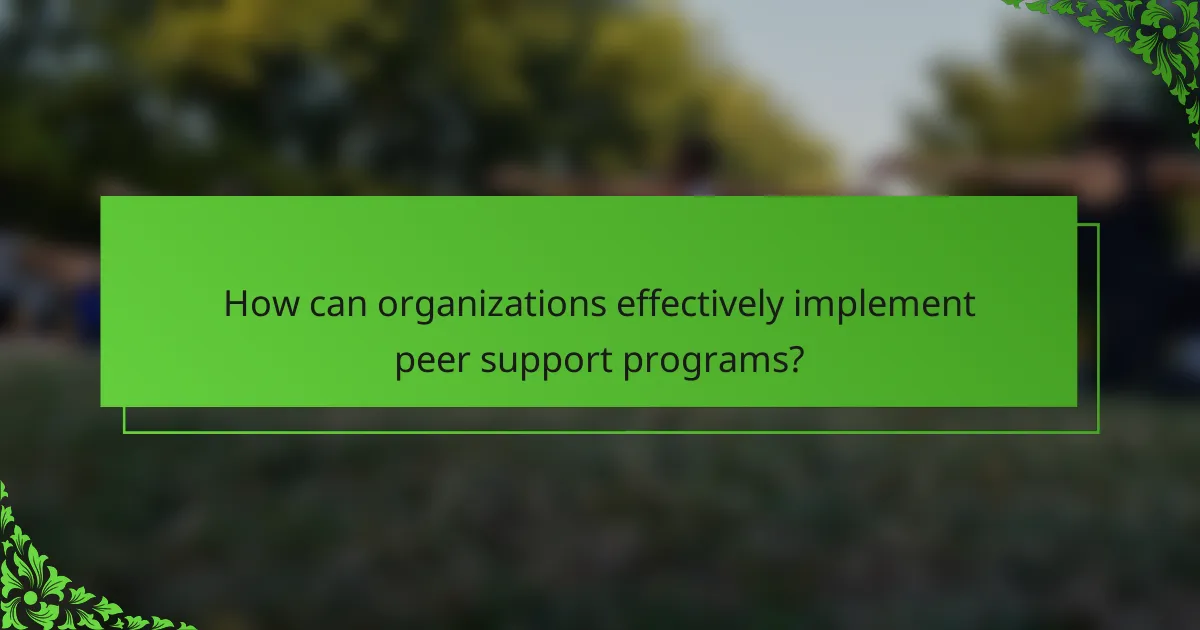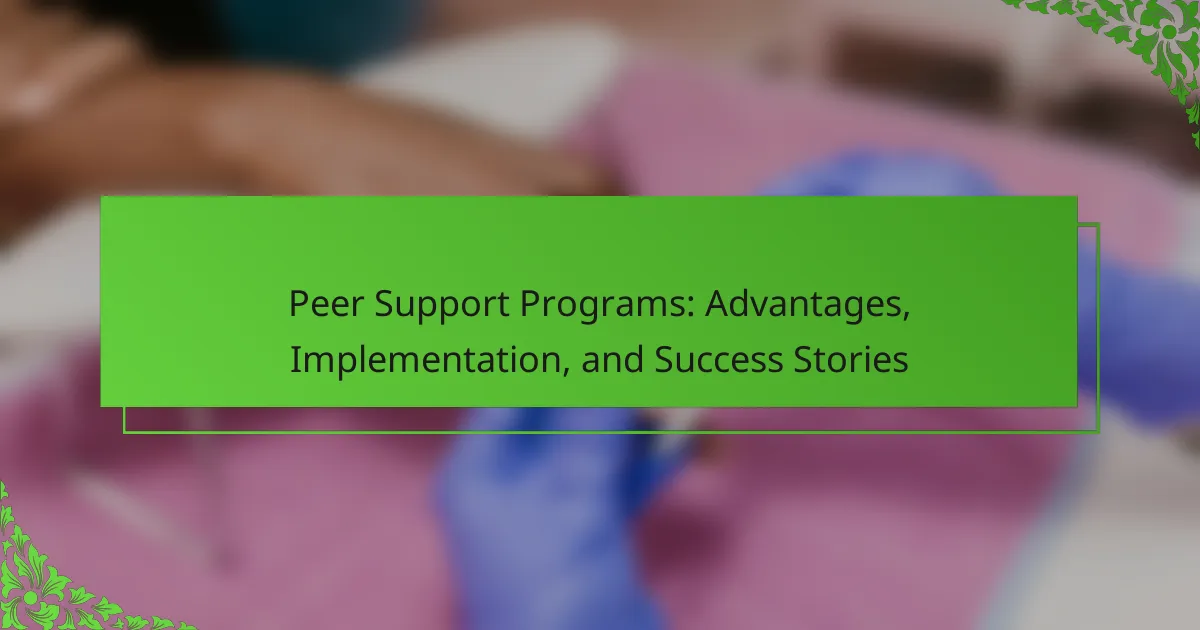Peer support programs enhance mental health outcomes and foster community connections. This article explores their advantages, effective implementation strategies, and notable success stories. Key aspects include tailored approaches, trained facilitators, and the importance of community engagement. Addressing challenges such as funding and participant engagement is crucial for sustainable success.

What are the primary benefits of peer support programs?
Peer support programs enhance well-being, foster community, and provide emotional support. They improve mental health outcomes, reduce feelings of isolation, and empower individuals through shared experiences. Participants often report increased confidence and coping skills. Additionally, these programs can lead to lower healthcare costs by promoting preventive care and reducing reliance on professional services.
How do peer support programs enhance mental health outcomes?
Peer support programs significantly enhance mental health outcomes by fostering community, providing emotional support, and sharing lived experiences. These programs create safe spaces for individuals to connect, reducing feelings of isolation and stigma. Research indicates that participants often report improved self-esteem and reduced symptoms of anxiety and depression. Success stories demonstrate that peer support can lead to lasting behavioral changes and increased resilience among individuals facing mental health challenges.
In what ways do peer support programs foster community engagement?
Peer support programs foster community engagement by creating inclusive environments that encourage collaboration and shared experiences. These programs enhance social connections, promote mutual understanding, and empower individuals through collective problem-solving. As a result, participants often report increased feelings of belonging and community cohesion. Additionally, peer support initiatives can mobilize resources and expertise within the community, driving local development and resilience.
What role do peer support programs play in reducing stigma?
Peer support programs significantly reduce stigma by fostering understanding and connection among individuals. These programs create safe spaces where participants share experiences without judgment. By normalizing conversations about mental health and related challenges, they help dismantle misconceptions. Success stories highlight how peer support leads to increased acceptance and reduced isolation, empowering individuals to seek help. As a result, communities become more supportive and inclusive environments, promoting overall well-being.

How can organizations effectively implement peer support programs?
Organizations can effectively implement peer support programs by fostering a culture of openness and providing adequate training. Establishing clear goals and objectives enhances program focus. Engaging stakeholders ensures buy-in and participation. Regular evaluation and feedback loops maintain program relevance and effectiveness. Success stories from similar organizations can inspire and guide implementation strategies.
What are the essential steps for establishing a peer support program?
To establish a peer support program, follow these essential steps:
1. Identify the target population and their specific needs.
2. Recruit and train peer supporters with relevant experience.
3. Develop a structured program framework outlining goals and activities.
4. Promote the program to encourage participation and awareness.
5. Monitor and evaluate the program’s effectiveness regularly.
These steps ensure the program meets its objectives and provides valuable support.
Which training methods are most effective for peer supporters?
Peer supporters benefit most from training methods that emphasize experiential learning and role-playing. These approaches enhance empathy and practical skills, vital for effective peer support.
Key effective training methods include:
1. **Role-Playing**: Simulates real-life scenarios to build confidence and communication skills.
2. **Mentorship**: Experienced peer supporters guide new members, fostering personal connections.
3. **Workshops**: Interactive sessions that cover specific topics, enhancing knowledge and skills.
4. **Feedback Sessions**: Regular evaluations help identify strengths and areas for improvement.
5. **Online Training Modules**: Flexible learning options that allow for self-paced skill development.
These methods create a comprehensive training experience, ensuring peer supporters are well-equipped to provide valuable assistance.
How can organizations tailor peer support programs to specific populations?
Organizations can tailor peer support programs by assessing the unique needs of specific populations. First, conduct surveys to identify preferences and challenges. Next, customize training for peer supporters to reflect cultural competencies and relevant experiences. Incorporate feedback mechanisms to adapt the program continuously. For instance, programs for veterans may focus on trauma-informed care, while those for youth might emphasize mental health awareness.

What unique features distinguish successful peer support programs?
Successful peer support programs are distinguished by their tailored approach, strong community engagement, and trained facilitators. These features foster trust and openness among participants, enhancing the overall effectiveness of the program.
Key distinguishing features include:
– **Tailored Programs**: Programs designed to meet specific needs of the target population increase relevance and engagement.
– **Trained Facilitators**: Skilled facilitators ensure that discussions are constructive and supportive, enhancing participant experience.
– **Community Engagement**: Active involvement of community members creates a sense of belonging and shared purpose.
– **Feedback Mechanisms**: Regular feedback from participants allows for continuous improvement and adaptation of the program.
– **Diverse Participation**: Inclusive programs draw from varied backgrounds, enriching the support network and perspectives shared.
These attributes contribute to the unique effectiveness and sustainability of peer support programs.
How do technology and digital platforms enhance peer support initiatives?
Technology and digital platforms significantly enhance peer support initiatives by improving accessibility and fostering connections. Online forums and apps allow users to engage anytime, breaking geographical barriers. Enhanced communication tools, such as video conferencing, enable real-time interaction, creating a sense of community. Data analytics can track engagement and outcomes, optimizing support strategies. Additionally, anonymity in digital spaces encourages more open sharing, enriching the support experience.
What innovative approaches are being used in peer support programs?
Innovative approaches in peer support programs include technology integration, personalized support plans, and community engagement strategies. These methods enhance accessibility, tailor assistance to individual needs, and foster a sense of belonging among participants. For example, online platforms enable remote connections, while workshops promote skill-building and resilience. As a result, these approaches improve overall program effectiveness and participant satisfaction.

What challenges do peer support programs commonly face?
Peer support programs commonly face challenges such as funding limitations, participant engagement, and training issues. These obstacles can hinder program effectiveness and sustainability.
Funding limitations often restrict resources for outreach and training. Participant engagement can fluctuate, impacting the support network’s reliability. Training issues may arise from insufficient preparation of peer supporters, affecting the quality of assistance provided.
Additionally, program evaluation can be challenging, as measuring success may require specific metrics. Cultural differences among participants can also complicate communication and understanding within the group. Addressing these challenges is crucial for enhancing the impact of peer support programs.
How can organizations overcome barriers to participation?
Organizations can overcome barriers to participation by fostering an inclusive environment and providing tailored support. Implementing peer support programs can enhance engagement by addressing individual needs. These programs create safe spaces for sharing experiences, leading to increased trust and collaboration among participants. Success stories show that organizations with effective peer support see higher retention rates and improved overall satisfaction.
What are the financial considerations for sustaining peer support programs?
Sustaining peer support programs requires careful financial planning and resource allocation. Key considerations include budgeting for training, operational costs, and potential funding sources.
1. Training costs: Allocate funds for training peer supporters to ensure effective program delivery.
2. Operational costs: Consider expenses such as materials, venues, and technology for program implementation.
3. Funding sources: Explore grants, donations, and partnerships to support ongoing financial needs.
4. Evaluation and impact measurement: Invest in tools to assess program effectiveness, which can attract further funding.
These financial considerations are vital for the long-term success and sustainability of peer support programs.

Which success stories illustrate the impact of peer support programs?
Peer support programs have demonstrated significant positive impacts through various success stories. One notable example is the “Mental Health Peer Support Program” in New York, which reported a 30% reduction in hospital readmissions among participants. Another success story is the “Peer Recovery Coach Program” in Ohio, where individuals with substance use disorders experienced a 50% increase in treatment engagement. These programs foster community, reduce stigma, and enhance recovery outcomes, illustrating the transformative power of peer support in diverse settings.
What lessons can be learned from successful peer support initiatives worldwide?
Successful peer support initiatives demonstrate the importance of community engagement and shared experiences. Key lessons include fostering trust, providing training for peers, and ensuring accessibility. Programs that prioritize cultural competence achieve better outcomes. Additionally, measuring impact through feedback enhances effectiveness and sustainability.
How do personal testimonials contribute to the credibility of peer support programs?
Personal testimonials significantly enhance the credibility of peer support programs by providing authentic experiences. These narratives foster trust and relatability, demonstrating real-life impact. Research indicates that 70% of individuals feel more confident in programs with testimonials. Personal stories often highlight unique attributes, such as emotional resilience and community connection, reinforcing the program’s effectiveness. By sharing diverse experiences, testimonials create a sense of belonging and encourage participation, ultimately leading to greater success in peer support initiatives.

What best practices should organizations follow when developing peer support programs?
Organizations should prioritize clear goals, comprehensive training, and ongoing evaluation when developing peer support programs. Establishing a supportive culture enhances engagement and effectiveness.
1. Define clear objectives to align the program with organizational goals.
2. Provide extensive training for peer supporters to equip them with necessary skills.
3. Foster an inclusive environment that encourages open communication.
4. Implement regular feedback mechanisms to assess program effectiveness.
5. Promote awareness of the program to ensure participation.
6. Evaluate outcomes continuously to adapt and improve the program.
How can feedback mechanisms improve peer support program effectiveness?
Feedback mechanisms significantly enhance peer support program effectiveness by fostering continuous improvement and participant engagement. They provide valuable insights into participant experiences and areas for enhancement. Regular feedback allows facilitators to adapt the program to meet evolving needs, ensuring relevance and effectiveness. Additionally, implementing structured feedback processes can lead to increased satisfaction and retention among participants, ultimately driving better outcomes for the program.
What common pitfalls should be avoided in peer support program implementation?
Common pitfalls in peer support program implementation include lack of clear goals, insufficient training for facilitators, inadequate participant engagement, and failure to evaluate program effectiveness. Addressing these issues enhances program success and sustainability. For example, setting specific objectives ensures alignment among stakeholders. Proper training equips facilitators with necessary skills, while engaging participants fosters a supportive community. Regular evaluations help identify areas for improvement, ensuring the program evolves to meet participants’ needs.



